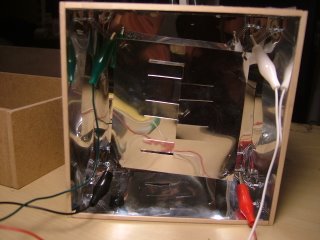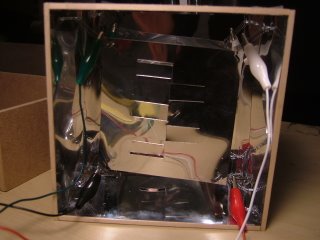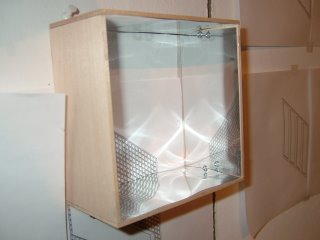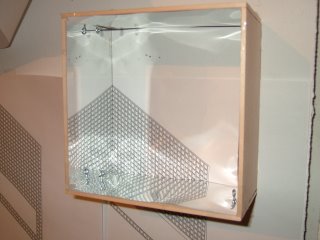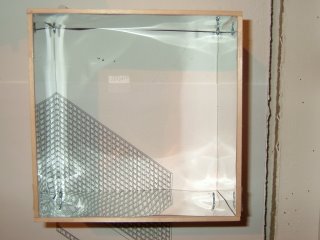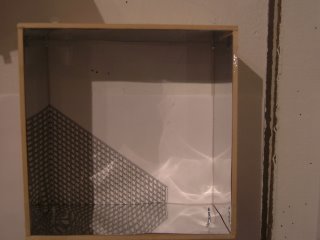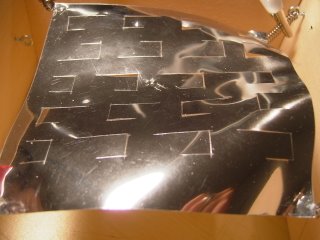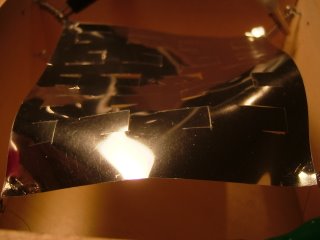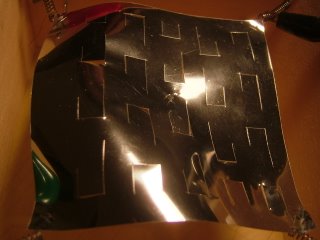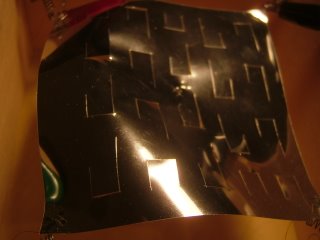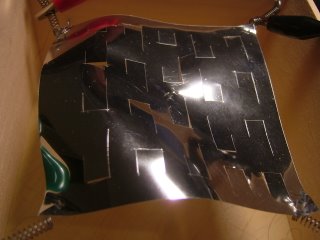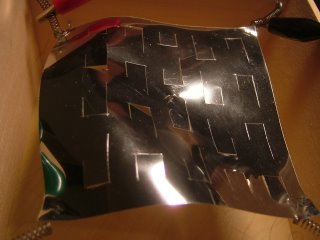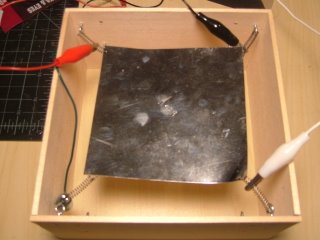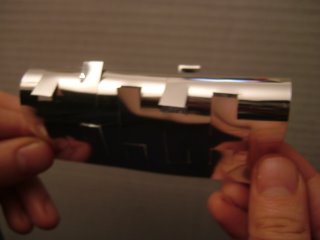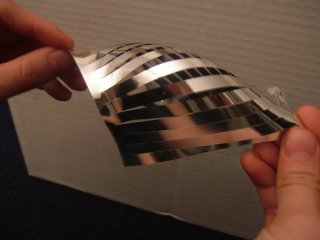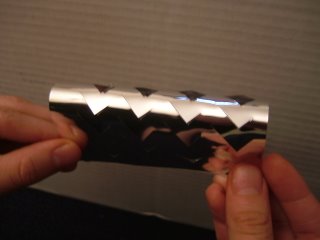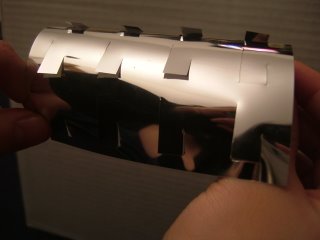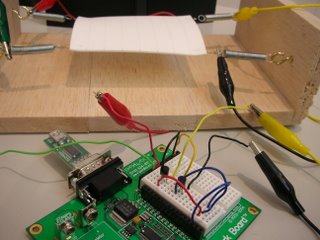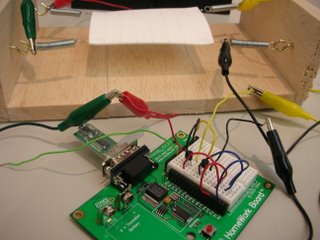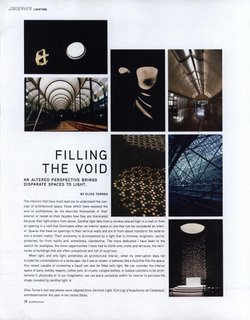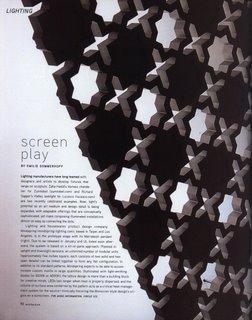Thursday, December 14, 2006
window/brick (stronger transistor)
window/brick 101
window/Brick material /In process
window/Brick material /In process
http://www.youtube.com/watch?v=byv9ArB8pQ0
window/brick full scale (original transitor)
Su + Stacy - New Prototype Videos
Su + Stacy New Prototype Images
Monday, December 11, 2006
full scale panel 201
Saturday, December 09, 2006
panel full scale 101
Tuesday, November 28, 2006
Su + Stacy: Reflective Mylar
Thursday, November 09, 2006
smart partition
Au, Yin
Pequeno, Perla
Living Architecture:
David Benjamin
Fall 06
Smart Partition
Input component-
-Current applied to Flexinol wires, which will travel to different panel position in strategically in a space.
Processing component-
-On/Off program with sensor/switch allowing the user to control the different stages of the panel, giving flexibility to the user.
Output component-
-Panels with scores and slits that when manipulated create an opening in the panel. When modulated and put together the series of panels create a wall/partition condition which, in this case, serves the purpose of sound manipulation within a space, as well as exploring the idea of private and share space.
When the panels are triggered, the openings are exposed and motion starts o occurred, letting sound/audible vibrations into a space, when close the space becomes a “sound-proof” zone. The secondary function of the panels consists on private vs. share zones.
Scale of a single "module" if you have one-
-scale of one of the panels should be 1 to 1, at this moment the design team is exploring the possibilities of panel communications as well as individual function.
Number of modules you will create
-4 modules should be give a good understanding of the idea in process.
Sitting (vertical, horizontal, indoor, outdoor, in a quiet environment, etc.)
-Vertical
The "twist" of the project
?
Vendors of all materials you will have to buy
Frame structure- wood, metal framing
Panel material- transparencies,
wood
fabric? (new idea)
List of technical issues and tests you will have to conduct in the next five weeks.
-Successful materials test- (sound proof and flexible)
-successful multiple panel connections
-exploration between individual to multiple movement control within panels.
- Switch control- processing and output.
Pequeno, Perla
Living Architecture:
David Benjamin
Fall 06
Smart Partition
Input component-
-Current applied to Flexinol wires, which will travel to different panel position in strategically in a space.
Processing component-
-On/Off program with sensor/switch allowing the user to control the different stages of the panel, giving flexibility to the user.
Output component-
-Panels with scores and slits that when manipulated create an opening in the panel. When modulated and put together the series of panels create a wall/partition condition which, in this case, serves the purpose of sound manipulation within a space, as well as exploring the idea of private and share space.
When the panels are triggered, the openings are exposed and motion starts o occurred, letting sound/audible vibrations into a space, when close the space becomes a “sound-proof” zone. The secondary function of the panels consists on private vs. share zones.
Scale of a single "module" if you have one-
-scale of one of the panels should be 1 to 1, at this moment the design team is exploring the possibilities of panel communications as well as individual function.
Number of modules you will create
-4 modules should be give a good understanding of the idea in process.
Sitting (vertical, horizontal, indoor, outdoor, in a quiet environment, etc.)
-Vertical
The "twist" of the project
?
Vendors of all materials you will have to buy
Frame structure- wood, metal framing
Panel material- transparencies,
wood
fabric? (new idea)
List of technical issues and tests you will have to conduct in the next five weeks.
-Successful materials test- (sound proof and flexible)
-successful multiple panel connections
-exploration between individual to multiple movement control within panels.
- Switch control- processing and output.
Thursday, November 02, 2006
one movement at a time video
Wednesday, November 01, 2006
Videos
Tuesday, October 31, 2006
REFERENCE: Colour by Numbers: Cell Phone Control of Tower Lighting
Tuesday, October 10, 2006
Flexinol Crimping Instructions Part 2
Flexinol Crimping Instructions Part 1
Monday, October 09, 2006
trial and error
Friday, October 06, 2006
Research: Lightings + Screens
Sunday, October 01, 2006
Posting Video Files
Friday, September 22, 2006
Research Proposal :yin, perla
Living Architecture Project 3
OBJECTIVES
The group will emphasize on the output condition.
Output = the physical change in relation to the input
INFLUENCE
- The team will experiment with the idea of direct force vs. indirect force application, resulting in variations of result.
- (Needle Toy) influenced the beginning of the project by allowing a simple and clear understanding of forces and a way for documentation of the phenomena.
- How It Works:
1. Force is directly applied into an object.
2. Force is transfer through a series of parallel pins order in a rectangular configuration. This allows a visual output.
3. The output reflects a physical change on the original state of the object.
4. The state of the object is controlled; the output allows for a physical materialization of a direct force.
PRECEDENTS
Some of the precedents to look at include:
Wooden Mirror
Party Wall by N Architects
GOALS
Base on the idea of the needle toy we want to further investigated the ideas of expansion and flexibility to space, in which how space can be adjusted by human being. For example, how the wall in a room starts to react when the minimum require space per person is over-limited. Then the wall will start to justify in order to fulfill the minimum space requirement of one person. The same concept can also be incorporated into a smaller scale object, such as a screen door, with adjustable panel that has different degree of openness for different requirement.
Vision:
This panel may also be used in a larger scale as a wall panel which can start to create spaces base upon the degree of openness-- an enclosed space, open space or the divider to exterior or interior. When all these panels are connected to each other, how one panel react will also influence the adjacent one.
PROJECT DETAILS
TESTS & MATERIAL
The beginning of the exploration will involve small scale experimentation with different types of materials as well as playing with the various thicknesses.
** Different Flexinol wire thicknesses will be tested with the different materials in the research.
Material Thickness Results
-Plywood........................... 1/64, 1/32, 1/16…………………………?
-Plexi-glass……………… 1/64, 1/32………………………………..?
- Metal ……………………1/64………………………………………?
-Meshes…………………………1/32, 1/16………………………….?
-Fabric
The second approach to experiment No.1 is to consider a series of procedures that will allow for specific movements and its variations.
Ø Test 1.0: Cutting the material in a grid pattern will allow for the material to expand.
Ø Test 1.1: Cutting the material in a horizontal pattern will allow for movement Test 1.2: Cutting the material in a vertical pattern will allow for movement
Ø Test 1.3: Cutting the material at an angle will allow movement.
SCHEDULE
OBJECTIVES
The group will emphasize on the output condition.
Output = the physical change in relation to the input
INFLUENCE
- The team will experiment with the idea of direct force vs. indirect force application, resulting in variations of result.
- (Needle Toy) influenced the beginning of the project by allowing a simple and clear understanding of forces and a way for documentation of the phenomena.
- How It Works:
1. Force is directly applied into an object.
2. Force is transfer through a series of parallel pins order in a rectangular configuration. This allows a visual output.
3. The output reflects a physical change on the original state of the object.
4. The state of the object is controlled; the output allows for a physical materialization of a direct force.
PRECEDENTS
Some of the precedents to look at include:
Wooden Mirror
Party Wall by N Architects
GOALS
Base on the idea of the needle toy we want to further investigated the ideas of expansion and flexibility to space, in which how space can be adjusted by human being. For example, how the wall in a room starts to react when the minimum require space per person is over-limited. Then the wall will start to justify in order to fulfill the minimum space requirement of one person. The same concept can also be incorporated into a smaller scale object, such as a screen door, with adjustable panel that has different degree of openness for different requirement.
Vision:
This panel may also be used in a larger scale as a wall panel which can start to create spaces base upon the degree of openness-- an enclosed space, open space or the divider to exterior or interior. When all these panels are connected to each other, how one panel react will also influence the adjacent one.
PROJECT DETAILS
TESTS & MATERIAL
The beginning of the exploration will involve small scale experimentation with different types of materials as well as playing with the various thicknesses.
** Different Flexinol wire thicknesses will be tested with the different materials in the research.
Material Thickness Results
-Plywood........................... 1/64, 1/32, 1/16…………………………?
-Plexi-glass……………… 1/64, 1/32………………………………..?
- Metal ……………………1/64………………………………………?
-Meshes…………………………1/32, 1/16………………………….?
-Fabric
The second approach to experiment No.1 is to consider a series of procedures that will allow for specific movements and its variations.
Ø Test 1.0: Cutting the material in a grid pattern will allow for the material to expand.
Ø Test 1.1: Cutting the material in a horizontal pattern will allow for movement Test 1.2: Cutting the material in a vertical pattern will allow for movement
Ø Test 1.3: Cutting the material at an angle will allow movement.
SCHEDULE
Thursday, September 21, 2006
Research: Agenda + Proposal
3 primary factors in the proposal
spatial [spey-shuhl]
–adjective
1. of or pertaining to space.
2. of, relating to, involving, or having the nature of space.
3. existing or occurring in space; having extension in space.
4. relating to, occupying, or having the character of space, affected with spatial disorientation
one may prejudge before entering the space and may have a sense of what’s occuring.
upon entering, the individual may realize, that they influence the space in which they’re in.
experience [ik-speer-ee-uhns]
-noun
1. a particular instance of personally encountering or undergoing something.
2. the process or fact of personally observing, encountering, or undergoing something.
3. knowledge or practical wisdom gained from what one has observed, encountered, or undergone.
4. the observing, encountering, or undergoing of things generally as they occur in the course of time.
experience is an important feature in the proposal. There should be a diaologue between the individual(s) and the skin.
kinetic architecture should be interactive with the people occuping the space.
functional [fuhngk-shuh-nl]
-adjective
1. capable of operating or functioning.
2. of or pertaining to a function or functions.
3. the action for which a person or thing is particularly fitted or employed.
4. the kind of action or activity proper to a person, thing, or institution
5. the purpose for which something is designed or exists; role.
it should take part on the interaction.
it should be something to encompass the human scale, and benefit and satisfies the human needs.
the space would have a field of skins with creases and lips that will open and expose lights and close depending on
- when the individual enters the space
- how the individual passes the skin
- the number of indivuals entering the space
- how the number of individuals pass the space
in areas where natural light may be available, the skin depending on what’s described above will reveal natural sunlight into the space.
in areas where natural light may not occur, the skins depending on what’s described above will reveal artificial light into the space.
in areas where both partial sunlight and artificial occur in the space, the skins exposure of natural sunlight and artificial sunlight may be placed depending on if that lighting is available.
we plan on going by this, by using specific sensors that will monitor a person’s presence in the space.
we would like to experience with various kinds of papers as well as textiles.
spatial [spey-shuhl]
–adjective
1. of or pertaining to space.
2. of, relating to, involving, or having the nature of space.
3. existing or occurring in space; having extension in space.
4. relating to, occupying, or having the character of space, affected with spatial disorientation
one may prejudge before entering the space and may have a sense of what’s occuring.
upon entering, the individual may realize, that they influence the space in which they’re in.
experience [ik-speer-ee-uhns]
-noun
1. a particular instance of personally encountering or undergoing something.
2. the process or fact of personally observing, encountering, or undergoing something.
3. knowledge or practical wisdom gained from what one has observed, encountered, or undergone.
4. the observing, encountering, or undergoing of things generally as they occur in the course of time.
experience is an important feature in the proposal. There should be a diaologue between the individual(s) and the skin.
kinetic architecture should be interactive with the people occuping the space.
functional [fuhngk-shuh-nl]
-adjective
1. capable of operating or functioning.
2. of or pertaining to a function or functions.
3. the action for which a person or thing is particularly fitted or employed.
4. the kind of action or activity proper to a person, thing, or institution
5. the purpose for which something is designed or exists; role.
it should take part on the interaction.
it should be something to encompass the human scale, and benefit and satisfies the human needs.
the space would have a field of skins with creases and lips that will open and expose lights and close depending on
- when the individual enters the space
- how the individual passes the skin
- the number of indivuals entering the space
- how the number of individuals pass the space
in areas where natural light may be available, the skin depending on what’s described above will reveal natural sunlight into the space.
in areas where natural light may not occur, the skins depending on what’s described above will reveal artificial light into the space.
in areas where both partial sunlight and artificial occur in the space, the skins exposure of natural sunlight and artificial sunlight may be placed depending on if that lighting is available.
we plan on going by this, by using specific sensors that will monitor a person’s presence in the space.
we would like to experience with various kinds of papers as well as textiles.
Monday, September 18, 2006
Interesting Article: Peel-and-stick electronics
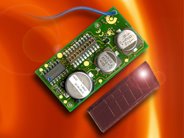
By Michael Kanellos Staff Writer, CNET News.com
Published: September 18, 2006, 12:11 PM PDT
Peel-and-stick electronics
Someday, installing a thermostat or remote volume knob for a home audio system might be as little effort as putting up a new air freshener.
Germany's EnOcean has come up with a series of sensors and switches that can extract energy from the environment and then transmit information via radio signals to a computer, which can then take the requested action. Because the sensors don't need to be linked to the building's electrical wiring, they can be installed without retrofitting. A dimmer switch, in other words, can be plunked on the wall without the need for cutting holes.
"One of the hot markets we are seeing is home automation," said Jim O'Callahan, vice president of EnOcean's U.S. operations. "You could have an 'all off' switch in your garage or your car that would turn off all the lights in your house. It could turn off the outlets with the coffee pot and things like that. There are systems that do this today, but you have to run Cat 5 (Category 5) wiring through the house."
Category 5 wiring is the unshielded, twisted-pair cabling normally used for computer networks and communications.
The system could also be employed to create microclimates (cool in the kitchen, warmer in the breakfast nook) or mood lighting in different rooms.
EnOcean, which spun out of Siemens and landed investments from 3i Group and BayTech Venture Capital, is one of several companies trying to eliminate one of the primary barriers to what could become a multibillion-dollar market for sensors--namely, power. If you scatter thousands of conventional sensors around a campus or industrial park, you'll have to hire an army of individuals to drive around and change the batteries all the time.
Rather than build long-life batteries, EnOcean is tinkering with ways to eliminate the need for them. It has been selling solar-powered sensors and is experimenting with sensors that can harvest electricity from vibrations and temperature differentials. As long as one surface is three degrees Celsius higher or lower than the immediate environment, EnOcean's prototype thermal sensor can harvest power.
"You could put it on a hot-water pipe. Typically, that will be warmer than the ambient air," O'Callahan said. "There are a lot of little spaces in buildings where the temperature differs by three degrees."
Wake-ups and power thresholdsVibration sensors, unless hooked up to a machine with fairly precise oscillations, are a little tougher to create.
None of these energy sources, however, can provide the electric wallop of a battery, so the company curbs power consumption by keeping the sensor dormant as much as possible.
A temperature sensor that works with a thermostat, for instance, might wake up to take a reading only every 15 seconds. If the temperature hasn't changed, it won't send a signal to the unit that actually adjusts the thermostat. The signal goes out only if the temperature exceeds a certain threshold.
"We also use a frequency without a high probability of interference" to prevent misfires in communication, O'Callahan said. "They are designed to continually harvest miniscule amounts of energy and store it. The real key comes in minimizing the power consumption."
How low can they go? Typically, the company's sensors--which include a sensing device, a microprocessor and a radio--can operate on 50 milliwatts.
The solar panel on the light-powered units measure 1 by 1.5 inches. A similar setup based on the ZigBee wireless sensor would require a solar panel 10 times larger, O'Callahan claimed. ZigBee chips also operate in the milliwatt range.
Despite the low energy requirements, the signal carries. In an environment like a warehouse, with few physical barriers, a signal from a sensor can travel 300 meters. If walls are present, the signal goes about 30 meters. Signals can also be relayed via other sensors.
EnOcean sells its products to building automation and other manufacturers, which use them to create devices. So far, the company has landed deals mostly in Europe. Building sensor specialist Thermokon has incorporated EnOcean's technology into solar-powered thermostats, while Denmark's Servodan has created a portable light sensor that sends a signal to a building control unit that then automatically raises or lowers window blinds.
About 100,000 EnOcean sensors have been put into use, the company says.
